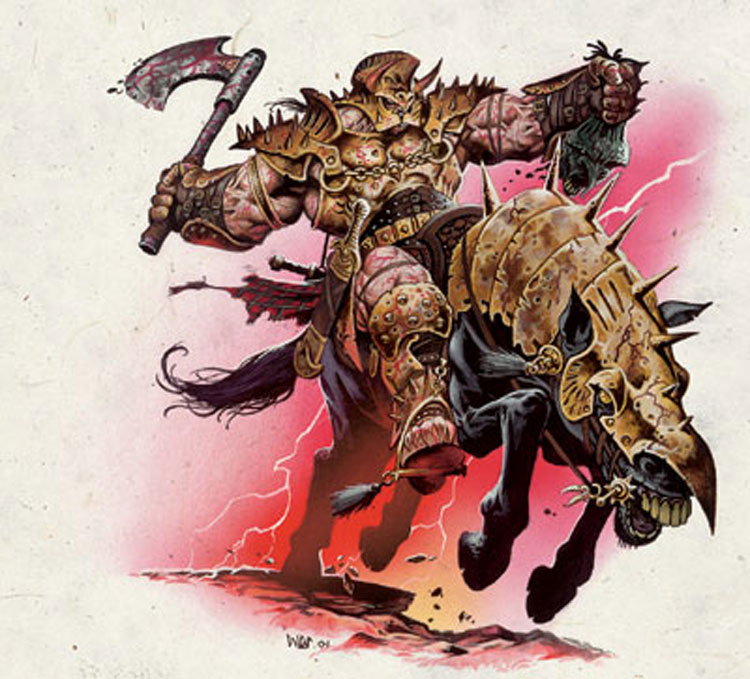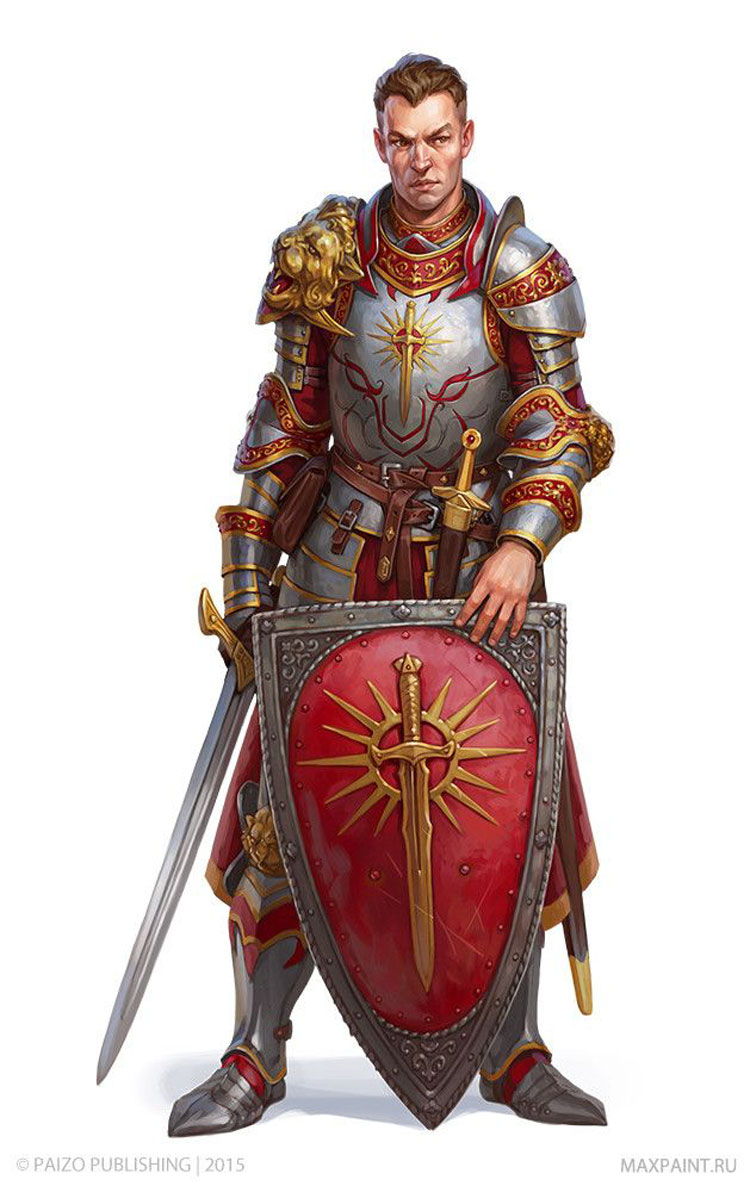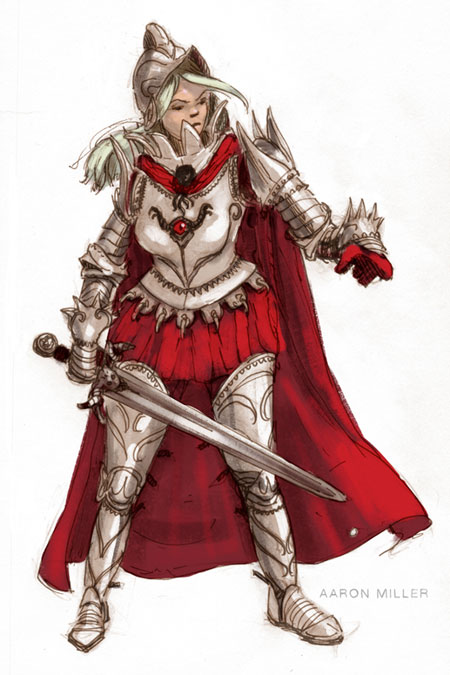Tempus
From astride his twin steeds--Veiros the white mare and Deiros the black stallion--Tempus (tem-pus) governs the tide of war and dispenses his favors at random, his chaotic nature favoring all sides equally in time. The deity of war is liable to back one army one day and another one the next. Soldiers of all alignments pray to him for help in coming battles. Mighty and honorable in battle and a strong and robust deity, Tempus answers only to his own warrior’s code and pursues no long-lasting alliances. He is known to love food, drink, and the hunt, though he loves battle best. He always appears as a human giant in battered and bloodied plate armor with his face hidden by a massive war helm. He bears a great battle axe or a black sword notched and stained from much use in his gauntleted hands.
Clergy and Temples
The church of Tempus is perhaps the most widely known in battle-stricken Abios. Countless centuries of warfare have unfolded on the battlefields of the world, and followers of the Foehammer have fought ably and honorably for all sides in nearly every such conflict. The independence of the Lord of Battles and his followers has ensured that his church is widely respected by members of all faiths, and none doubt that they too might prevail in the next battle if only the Foehammer’s fickle nature smiles their way again. Nearly every combatant has fought alongside a cleric of Tempus at some point or the other, and just as many have also fought against a cleric of Tempus.
Tempus’s clerics pray for spells just before high sun. The eves and anniversaries of great battles are the holy days of the church of Tempus, and as such vary from place to place. The Feast of the Moon, honoring the dead, is the most important fixed date in the religious calendar. Each temple holds a Feast of Heroes at high sun and a Song of the Fallen at sunset, and most also have a Song of the Sword ceremony after dark for lay folk. It is also expected that at least once a ten-day worshipers of Tempus spill a few drops of blood (preferably their own or a worthy foe’s) and sing the Song of the Sword in Tempus’s honor. The ritual performed by most of the faithful is a prayer for valiant performance and survival in the fray ahead, made to the war deity over the weapon the praying being most often fights with. If a new weapon comes into the believer’s possession before a battle--particularly in the form of hard-won booty--it is taken as a sign of Tempus’s favor, and this weapon is the one used in worship. Tempus’s clerics usually multiclass as barbarians or fighters. Most tend to be battle-minded male humans, although others are also welcome.
Clerics of the war deity are charged to keep warfare a thing of rules, respected reputation, and professional behavior, minimizing uncontrolled bloodshed and working to eradicate feuding that extends beyond a single dispute or set of foes. At the same time, training and readiness for battle must be promoted if civilized human holdings are to survive in Abios in the face of monster raids and Orc hordes--and the power of Tempus to aid those he favors in battle must also be promoted. Warriors who employ poison or taint wells, sow fields with salt, kill noncombatants, indulge in torture or the wanton slaughter of innocent folk when they are not at war, or commit similar things against fair battle are to be denied the favor of the deity, their crimes are to be publicized far and wide, and they are to be made to atone for their deeds or perish. War clerics must preserve the names of the honored battle-fallen, both on gravestones and other such memorials, in their prayers to Tempus, and in an annual chant at the March of the Dead, wherein clerics of the war deity go through the streets to call all folk, worshipers and nonbelievers alike, to the local Feast of the Moon hosted by their temple. Clerics are also charged to collect and venerate the weapons and armor of famous and respected warriors, even if these are broken or have deteriorated, for they retain something of the battle lust and energy associated with the deeds they participated in.
Temples of Tempus are usually what are more commonly thought of as walled military compounds than what most picture as temples. Aside from a central shrine to honor fallen decorated with the battered shields and rusted blades of the dead, most temples of Tempus are given over to the necessities of warfare, including armories, barracks, and training grounds. The wealthiest fortified abbeys sometimes contain libraries, but such contain only a history of warfare and an accounting of the fallen.
When not in battered armor, cleric of Tempus often wear helms or steel skullcaps, though they are careful never to cover their faces, for such close emulation of Tempus is thought to be an affront to the Lord of Battles. Some of the fanatical wandering clerics never remove all their armor at any time, but in the temples of the big cities clergy are rarely seen in armor except at ceremonies held before armies march or a siege begins. The formal robes of a cleric of Tempus always sport trim the crimson hue of fresh blood, but vary in overall color from place to place and rank to rank, with darker-colored robes are worn by those of lower ranks. Most war clerics wear ceremonial garments of brown or purple. Red or amber is worn by senior clergy, and yellow or white by those of the most exalted rank. Aside from their trusty battleaxes, many senior clerics of Tempus also favor spiked gauntlets as a mark of their station.
Given its predilection to support both sides of any fight, the church of Tempus necessity lacks any central authority that might come down in favor of one side or the other. However, within a given temple or military order, there is usually a strict adherence to military rank and a cleric chain of command. The Tempuran church also has many affiliated orders. Two of note are the Order of the Broken Blade and the Order of the Steel Fang. The former honors those warriors and clergy who are injured in Tempus’s service and can no longer fight in the front lines. Broken Blades often serve in support functions at temples and shrines and take a personal oath upon joining the order to defend the holy site where they reside to the death as a final line of defense. The latter group is an elite fighting order within the church whose members are often assigned to the most hazardous duties. Steel Fang units are led by battle-hardened members of the clergy. Many mercenary companies and knightly fighting orders of crusaders also avail themselves of a connection to the church. One badge of the deity seen among his affiliated mercenaries is a rusty brown dagger, shown diagonally with its point to the upper right, dripping four drops of blood.
Dogma
Tempus does not win battles, he helps the deserving warrior win battles. War is fair in that it oppresses and aids all equally and that in any given battle, a mortal may be slain or become a great leader among his or her companions. It should not be feared, but seen as a natural force, a human force, the storm that civilization brings by its very existence. Arm all for whom battle is needful, even foes. Retreat from hopeless fights but never avoid battle. Slay one foe decisively and halt a battle quickly rather than rely upon slow attrition or the senseless dragging on of hostilities. Remember the dead that fell before you. Defend what you believe in, lest it be swept away. Disparage no foe and respect all, for valor blazes in all regardless of age, sex, or race. Tempus looks with favor upon those that acquit themselves honorably in battle without resorting to such craven tricks as destroying homes, family, or livestock when a foe is away or attacking from the rear (except when such an attack is launched by a small band against foes of vastly superior numbers). Consider the consequences of the violence of war, and do not wage war recklessly. The smooth-tongue and fleet of feet that avoid all strife and never defend their beliefs wreak more harm than the most energetic tyrant, raider, or horde leader.
History and Relationships
Tempus arose from the first battle between Selûne and Shar, one of many such war deities to walk the world. In time, he defeated each and every one of his rivals in battle, the last of which was Garagos the Reaver. Some oracles claim that in years to come Tempus may find himself at war with the Mulhorandi pantheon. In recent years, Tempus sponsored the divinity of the Red Knight, a relationship akin to that of a fond and protective father to a brilliant daughter who works hard at the family business--war. The Foehammer is casually friendly with martially inclined deities such as Gond, Valkur, and Uthgar. It is unclear why Tempus tolerates the continued survival of Garagos, although some sages have speculated that Tempus knows that a new challenger is inevitable and he prefers to use the Reaver as a stalking horse to draw out such potential foes. Others claim that Garagos represents that one bit of warfare that Tempus finds personally distasteful, the savage madness of a battle rage, and that he deliberately ceded that aspect of the portfolio of war, though he is still worshiped by many barbarians.
Divine Classification
Greater Deity
Honorary & Occupational Titles
- Lord of Battles
- Foehammer
Children
Gender
Male






